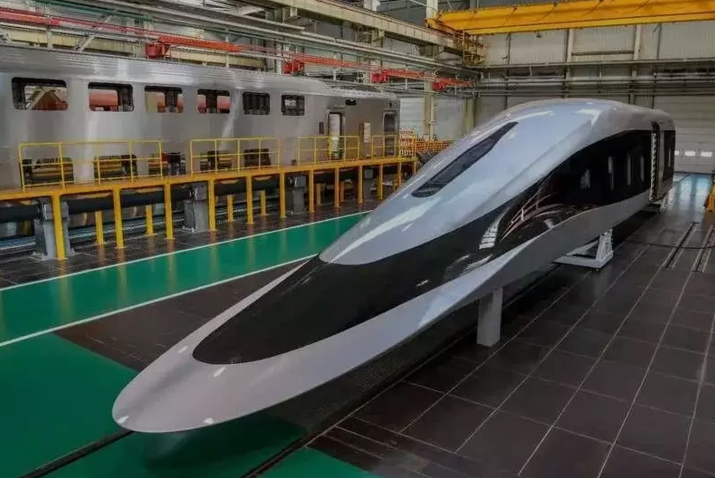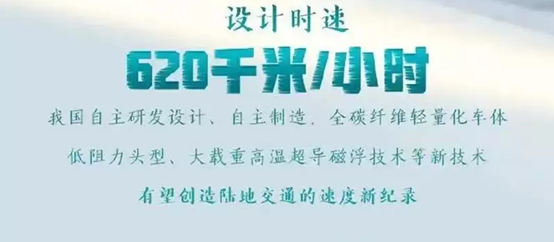
0086-18362561302

In our impression, maglev train does not touch the track and suspends in the air that is very magical. Just yesterday, the world's first high-temperature superconducting high-speed maglev engineering prototype vehicle weighing 12 tons came off the production line. It is like a leaf floating on the water, which can be easily pushed forward by hand.

The first one in the world!
620km / h HTS high speed maglev prototype vehicle comes off production line
January 13th
Designed and manufactured by China
World's first HTS high speed maglev engineering prototype vehicle and test line
Officially on the track
Design speed is 620km / h
It marks a breakthrough in engineering research of HTS high speed maglev.


The HTS high speed maglev engineering prototype vehicle and test line project is located at State Main Laboratory of traction power, Southwest Transport University. Total length of verification section is 165 meters, which is jointly researched and developed by CRRC, China Railway, Southwest Transport University and other units equally involved in development.
High temperature superconducting maglev technology has characteristics of self suspension, self guidance and self stability, which is suitable for future vacuum pipeline transportation. In low vacuum state, theoretically predicted speed of high temperature superconducting maglev train can be higher than 1000 km / h.
High temperature superconducting maglev train full of "black technology"
Can you imagine "never derail" and "driverless"?
Even more incredible
One person can push it with his bare hands!
Self levitation | it can "never derail"

HTS high-speed maglev engineering prototype vehicle adopts streamline design and shaped like a sub warhead. Unlike high-speed railway, which is driven by on-board power supply to "run" on the rail, sample vehicle is suspends on permanent magnet track, with a linear motor in the middle of track, superconducting suspension device installed at the bottom of the vehicle to replace wheels. Whole vehicle body is still about 10 mm away from the track.
Yes, it can also "float" alone when it is still!
Self suspension, self stability and self guidance are its biggest benefits. Superconductor is installed at the bottom of the train, and track is a permanent magnet. Under action of liquid nitrogen, two parts (train and track) produces this suspended condition and train car gets characteristic of "pinning" in the air.
Like magnets we used to play with when we were children when they repel each other, in the same way car body naturally floats. This kind of "self-suspension" makes full use of physical characteristics and does not require additional energy. As long as superconducting state exists, system can automatically "pull back" car body regardless of force applied to the car in any direction.
At present, only this sample car in the world has "super ability" of "self-suspension". Take "low temperature superconducting magnetic levitation" under construction in Japan as an example. This kind of vehicle runs like an airplane taking off. It must "run up" for a certain distance before it can generate magnetic force and car body can float.
Lightweight | one person drives one train

At the opening ceremony, Professor Deng Zigang, who participated in research and development, jokingly said to his friends at the scene, "push the train and have a look”.
A train weighing more than ten tons, push it? With curiosity, my little friend really pushed hard, and then … car's gone!
The scene of "pushing the train by hand"
How to push a train by one person?
First of all, it floats at rest, and there is no friction between it and track, that is why it can run fast.
Secondly, car body is made of carbon fiber material, which is about 50% lighter than current high-speed train. This is because train suspension capacity is certain, so car body must be lightweight. The lighter car body is, the more passengers can be taken. For this reason, HTS high-speed maglev train body will be smaller than existing high-speed train body.
Driverless | power system hidden on the track

On test line, in the middle of two permanent magnet tracks, there are circles of orange coils. What is this?
This is a linear motor, which is the power system of high-speed HTS Maglev train. Compared with traditional rotating motor, driving force of linear motor is greater, so train can run faster. In addition, compared with traditional high-speed trains, "head-type" sample train is longer. There is no friction between wheel and rail, the rest is air resistance, the longer head is, the smaller air resistance becomes.
Inside, in front of the car there is a row of simple console. There is no power system on front of the car. Operation of the vehicle relies entirely on remote control of linear motor by ground computer to implement unmanned driving. Driving force of linear motor can be forward or backward for deceleration and braking of the train. However, a row of control buttons are still set at the front of the train. There is still management personnel on the train to monitor real-time operation of the train. In case of emergency, emergency braking can be implemented.
Not only sense of "black technology" is full on the train.
High temperature superconducting maglev train also has many advantages
Energy saving: suspension and guidance do not need active control and vehicle power supply, so system is relatively simple. Suspension and guidance only need cheap liquid nitrogen (77 K) for cooling, and 78% of air is nitrogen.
Environmental protection: high temperature superconducting magnetic levitation can be suspended in a static state without noise; permanent magnetic track produces a static magnetic field, and magnetic field at passengers’ seat is zero, so there is no electromagnetic pollution.
High speed: suspension height (10-30 mm) can be designed according to the needs, and can be used from static to low, medium, high speed and ultra-high speed operation. Compared with other maglev technologies, it is more suitable for vacuum pipeline transportation (more than 1000 km / h).
Safety: suspension force increases exponentially with decrease of suspension height, safe operation can be ensured without control in vertical direction. Self-stable guidance system can also ensure safe operation in horizontal direction.
Comfort: special "pinning force" of high temperature superconductor keeps car body stable up, down, left and right that is difficult for any vehicle to achieve. What passengers feel when they ride is "feeling without feeling".
Low operating cost: compared with conventional magnetic levitation vehicle in Germany and cryogenic superconducting magnetic levitation vehicle in Japan, maglev has advantages of light-weight, simple structure and low manufacturing and operating costs.

The technology was developed first to achieve engineering in atmospheric environment; expected operating speed target value is greater than 600 km / h that is supposed to set new speed record of land transportation in atmospheric environment. The next step is to break through speed threshold of more than 1000 km / h in combination with future vacuum pipeline technology to create a new mode of land transportation and trigger forward-looking and disruptive changes in development of rail transportation.

Add WeChat to learn more